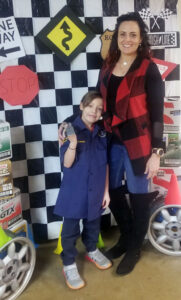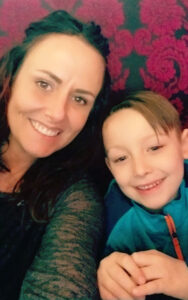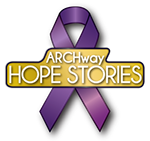Heidi Schmeling
A Beacon of Hope for Others
Stories of Hope
ARCHway believes in recovery from the disease of addiction.
Heidi is in long term recovery with a sober birthday of December 26, 2012.
Interviewed by Emily Jung
After years of active substance use, the road to her recovery was beyond difficult, harder than one could possibly imagine, but the fight was worth it.
Today, seven years later, she is working in a career she loves as an interior designer, is a wonderful mother to her son, Oliver, and is surrounded by a support system of family and friends. Heidi continues to work on her recovery daily and lives a happy and healthy lifestyle that’s not without its challenges, especially as a single parent. The obstacles she has overcome because of her addiction have allowed her to gain life lessons and skills, a support system, a resiliency, and a change in her overall core values making her a wonderful, inspiring woman to be around, a woman who encourages others daily. Today, Heidi lives happy, joyous, and free from her addiction.

 Heidi grew up in the suburbs of St. Louis in a family free from addiction. There was little to no alcohol in her house on a regular basis. She went to Catholic School from kindergarten through eighth grade, and she considered her life pretty sheltered until high school. She attended Oakville, a public high school, and it was this environment where she was exposed to alcohol and drugs. Accompanying this access to substances and simple curiosity, Heidi struggled like many adolescents with self-esteem, and she also faced anxiety. She said she really wasn’t sure where she fit. She found her way to multiple friend groups, and in each group she behaved slightly different in order to fit into that group. She was afraid to be herself and/or she didn’t quite know who she was.
Heidi grew up in the suburbs of St. Louis in a family free from addiction. There was little to no alcohol in her house on a regular basis. She went to Catholic School from kindergarten through eighth grade, and she considered her life pretty sheltered until high school. She attended Oakville, a public high school, and it was this environment where she was exposed to alcohol and drugs. Accompanying this access to substances and simple curiosity, Heidi struggled like many adolescents with self-esteem, and she also faced anxiety. She said she really wasn’t sure where she fit. She found her way to multiple friend groups, and in each group she behaved slightly different in order to fit into that group. She was afraid to be herself and/or she didn’t quite know who she was.
How many of us felt that way growing up or at times continue to feel that way as adults? How many of us have kids or know kids that feel the same? Heidi’s past insecurities are similar to many adolescents, but Heidi explained how at that point in her life she didn’t know how to manage those insecurities or her anxiety. She said, “I didn’t know how to talk about my feelings, to tell people how I was feeling…instead, I found marijuana and alcohol.”
She started consuming alcohol sophomore or junior year and began seeking out marijuana after watching the fan favorite, Dazed and Confused. And it was these substances that became Heidi’s coping mechanism for her insecurities, her self-esteem issues, and her anxiety.
 In high school and even in college, Heidi didn’t face many consequences for her substance use other than the occasional hangover. She passed high school, doing just what she needed to in order to stay under the radar. She wasn’t skipping school or getting in trouble; she didn’t stick out as someone struggling with substance use at that time, so her teachers didn’t have a need to reach out. She remembers getting caught by her parents, and despite their attempts to ground her, nothing they did was going to change how she looked at drugs and alcohol.
In high school and even in college, Heidi didn’t face many consequences for her substance use other than the occasional hangover. She passed high school, doing just what she needed to in order to stay under the radar. She wasn’t skipping school or getting in trouble; she didn’t stick out as someone struggling with substance use at that time, so her teachers didn’t have a need to reach out. She remembers getting caught by her parents, and despite their attempts to ground her, nothing they did was going to change how she looked at drugs and alcohol.
In junior college, she moved on to other recreational drugs like cocaine and ecstasy, and this use would only accelerate when she went away to college and worked as a waitress. This was also when she was exposed to prescription pain pills after multiple surgeries (tonsillectomy, wisdom teeth removal, and appendectomy). These were pretty routine surgeries, but each time she didn’t take the pain medication as prescribed, and she shared it with her friends. Despite all this, she wasn’t getting DWIs, she was passing classes, she was holding a job, sometimes up to three jobs at a time. She was functioning, and her partying was limited to nights, weekends, and holidays.
It seemed normal. She said, “I thought all those things were normal because the people that I hung around all did the same exact thing…everyone drank and did drugs like I did.”A lot of adolescents and young adults do see this behavior as normal.
After graduation, Heidi moved to a loft off Washington Avenue in St. Louis with her boyfriend, continued to go out on the weekends, and continued to use substances. She would begin receiving prescription opiates once again; this time for hip pain, which again she shared and didn’t take as prescribed. Eventually this progressed to stronger opiates and later heroin. She remembers her first introduction to heroin vividly. Her boyfriend at the time brought it to her saying, “This is the same thing as OxyContin. I think it might be heroin, but it’s the same thing.”
And that was all it took for Heidi. At that point no one was talking about heroin, so she lacked the education and awareness of the drug, its power, and its effect. The feeling she got from using heroin that day was better than any anxiety or fear that she had going on in her head, so she would continue to pursue it, but she had no idea what she was getting herself into.
 Heidi’s heroin use progressed and would continue on and off for eight years. It became her only coping mechanism, and she would begin to see consequences. She began taking out cash advances on credit cards in order to buy drugs, she isolated and no longer cared about going out with friends, and she stopped going to family functions. She began experiencing withdrawal symptoms when she didn’t use. Again without education/awareness of heroin, she had no idea that if you didn’t continue to use, you were going to get sick. She was forced to use everyday or she risked that sickness. Heroin had its hooks in her so deep that she no longer had control and no longer saw a way out.
Heidi’s heroin use progressed and would continue on and off for eight years. It became her only coping mechanism, and she would begin to see consequences. She began taking out cash advances on credit cards in order to buy drugs, she isolated and no longer cared about going out with friends, and she stopped going to family functions. She began experiencing withdrawal symptoms when she didn’t use. Again without education/awareness of heroin, she had no idea that if you didn’t continue to use, you were going to get sick. She was forced to use everyday or she risked that sickness. Heroin had its hooks in her so deep that she no longer had control and no longer saw a way out.
She said, “Once it has a hold of you that hard, you will do anything not to feel that sickness,” which she described as the worst feeling in the world accompanied by an unexplainable amount of anxiety, fear, and desperation.
While in active heroin addiction, Heidi vaguely recalled getting engaged on a family cruise. She remembered getting married and snorting heroin with her husband on their wedding day. This wedding would be followed by a divorce and having to file for bankruptcy. Heroin had her stealing, lying, and doing things to get money that would cause more trauma. She couldn’t hold a job. Heidi explained, “I would go to any length to get what I needed, to get well and to stay well.” Those words, “To get well and to stay well,” are key to understanding substance use disorder.
Stigma tells us to immediately question:
- How could she do those things?
- Why couldn’tshe just stop using?
Whereas the symptoms of the flu include fever, muscle aches, and nausea, the symptoms of a substance use disorder include:
- Economic symptoms (loss of job, lack of money)
- Social symptoms (loss of family/friends)
- And behavioral symptoms (lying, stealing, and depression)
So stigma tells us one thing, but science tells us that the chemical make-up of her brain was changed by the drug, and Maslow’s Hierarchy of Needs tells us that in order to meet her basic physiological needs (air, water, food, shelter), she had to use. When you have the flu, you go to the doctor who prescribes medication to relieve you of your symptoms: reduce your fever and ease your body and stomach. In the same sense, Heidi needed medical attention to treat her disease, to help heal the brain in order to relieve her of her economic, social, and behavioral symptoms.
She found the Assisted Recovery Centers of America (ARCA), a medically assisted treatment facility in St. Louis and would make her way back there about seven times, making it almost like a second home to her as she described. The protocol was that she would detox using Suboxone and then switch over to Vivitrol. However, even with the medication, she just couldn’t get anything to stick. She would later realize that in addition to help from the medications, she needed a change in mindset. Heidi said, “I didn’t see that I was really the problem, and I didn’t know how to live, and I didn’t know how to act without drugs and alcohol.” She continued to think that if she got rid of heroin, then everything would get better.
She found the Assisted Recovery Centers of America (ARCA), a medically assisted treatment facility in St. Louis and would make her way back there about seven times, making it almost like a second home to her as she described. The protocol was that she would detox using Suboxone and then switch over to Vivitrol. However, even with the medication, she just couldn’t get anything to stick. She would later realize that in addition to help from the medications, she needed a change in mindset.
Heidi said, “I didn’t see that I was really the problem, and I didn’t know how to live, and I didn’t know how to act without drugs and alcohol.” She continued to think that if she got rid of heroin, then everything would get better.
With this mindset, she continued to use other substances even while she was clean from heroin, which would eventually cause her to relapse and have to start the process all over again. She remembers being clean from heroin for almost a year and being offered an Oxycontin at her 30th birthday party while she was drinking, and without giving much thought at all, she took it. From that point, she would continue to use heroin for three more years. This mindset would continue even once she found herself pregnant at 34 years old. At that point she was clean off heroin and on Vivitrol, but her doctor took her off this medication because it had not been proven safe during pregnancy. Heidi still wonders if taking her off this medication was a good idea, because she did continue to use her entire pregnancy.
The day she gave birth to her son, she was alone. She was scared. She was sick.
The Department of Family Services was involved at that point, and she knew her child was going to be taken away. With this threat, she wanted to get clean. She wanted to keep her baby, so while pregnant, she decided once again to detox using Subutex prescribed by her doctor, and this combination would push her into early labor. So, alone, scared, and sick, Heidi remembers texting her drug dealer, who immediately said, “Come over and I can help you feel better.” And for the first time, despite being to a point of total desperation, she thought, “What’s the point?” In her interview with ARCHway, she explained her thoughts at this moment:
She said, “So what? You can get me off sick, but I’m going to have to do this all over again tomorrow and the next day and the next day. This was the first time that I had actually thought, why? I was just so tired of the game of how to get money to get the dope to get high over and over and immediately the high is never what it once was, and you’re never getting what you want out of it, and I’m never feeling in a safe place, and I’m always full of anxiety. So I just said no.”
And that’s when she dialed 911, and waited, a million thoughts running through her mind: I might be in labor but I’m not 100 percent sure. I think I need help, but I’m going to have to admit that I’ve been using heroin. And once she hit send, that would be the first time that she admitted out loud that she was actively using heroin while she was pregnant with her son, that she “was hurting an innocent child, that didn’t have a choice.” It wasn’t without tears that Heidi explained this event. Many of her big life’s moments: engagement, marriage, the birth of her child were scared by her substance use, but this didn’t have to continue to be her story. And in fact, Heidi became determined to change her story. Heidi fought like hell and has been sober since the birth of her son.
Recovery
The last seven years of recovery for her have not been easy. It has taken a lot of work, a lot of change, and simply a lot of different supports, which she explained. First and foremost, she had an aunt and uncle who stepped up to foster her son, Oliver. At the time, her aunt and uncle honestly didn’t think that she was going to get better; they figured they would be adopting her son. Heidi describes these two as her angels, and she will be forever grateful to them as she is to the rest of her family, for the love and support they provided throughout her addiction and her recovery.
She started Family Drug Court, a voluntary program for mothers who have had a child taken away due to substance use. She said, it “turned out to be the best thing that ever happened to me in my life.”
She was forced to stop using all substances meaning she couldn’t continue to drink, and without any substances numbing her emotions, she would have to learn new coping mechanisms for dealing with her anxiety and trauma. She also started doing exactly what people were telling her to do. She gave up on making her own decisions, on doing things her way. She said her way got her into that situation, so she needed to try something different, and that something different looked like Vivitrol, PTSD counseling, individual counseling, group therapy at ARCA, parenting classes, a full time job, and 12 step meetings.
Twelve step programming became very important to Heidi’s recovery, and it still is today. It was in these meetings that she found the support and the love she needed, and the 12 step literature would give her certain principles to live by. Heidi joked that “normal” people don’t need a book to tell them how to live and “normal” people definitely don’t need someone to walk them through this book. However, addict or otherwise, we can all learn something from the life principles that 12 step programming promotes. Heidi is a prime example of that, because today she lives by these principles and by a set of core values that make her the best version of herself.
Heidi also developed a relationship with her high power through 12 step programming. Up to that point, she had always believed in God. However, she explained that her belief system had to fit in a box; she felt forced to follow a certain set of rules, but her sponsor expanded that box for her and for the first time, she was allowed to develop her own concept around a higher power.
Heidi said, “Having a higher power, somebody else to count on, has taken away so much of that fear and anxiety…it’s taken a long time, but it’s been a beautiful thing.”
Today, Heidi no longer copes with life’s struggles using substances. She takes advantage of her support system, her family, her friends in recovery, her high power, and all the lessons and values she’s developed through her addiction and otherwise. It took a lot, but it was worth it.
Heidi received custody of her her happy and healthy baby boy, Oliver, when he was eight months old. While learning to take care of a baby, Heidi stayed consistent with her recovery, and she continued to work her full time job. She is still consistent and incredibly active with her recovery today, because she knows she has to in order to be the best version of herself and the best mom to her son.
Today, first and foremost she is a mother, and she gives a lot of focus and attention to her son and his needs. Also, each morning when she wakes up, she makes her bed and prays. She reminds herself of where she once was and thanks God for her sobriety. She tries to make contact with at least one other woman in recovery each day, and she reaches out to women who are still struggling because she knows where they are, how they feel, and that she has the ability to inspire and give hope to them. She attends 12 step meetings weekly, she sponsors women in the program, and she does service work. Besides her full time job and being a full time parent, she volunteers for a non-profit called Addiction is Real, which focuses on educating parents and community members on substance use and increasing prevention of substance use.
Heidi is also open about her recovery today even with her co-workers because chances are someone, somewhere is dealing with addiction, and if she doesn’t share, she knows she can’t help. Sharing her story, the good and the bad, requires Heidi to be vulnerable, but it’s this vulnerability that allows others to open up to her about their own struggles. Heidi said,
“That’s what’s so beautiful about recovery is that we can continue to give each hope and when I am struggling with something, I will reach out to somebody else and if they haven’t been through it, they are going to refer me to somebody who has…it’s a whole community and we just help each other continue to live.”
The positivity and light that radiates from Heidi is definitely contagious, and she owes that to her recovery, the work she did to get there, and the people who helped her along the way. Her values have changed. She exudes honesty. She always leaves things better off than how she found them. She said, “Leave things in a better way, whether that be picking things up or coming into a room and not being the negative energy in that room.” She also tries to live in the moment today, not dwelling on her past or worrying for her future. She reminds herself of all the things she has to be grateful for without comparing herself to others.
Because Heidi is very active in the recovery community, she sees individuals facing barriers to treatment. She sees a lack of aftercare or follow-up care from things like Family Drug Court, a lack of sober living and other general resources for women and those who have children, and of course, she sees a lack of funding for people who need treatment services. Heidi said, “There are a lot more opportunities today to get into rehab, but again, most addicts and alcoholics when they’re to a point when they’re ready for help, they don’t have insurance…how do you get help for people who can’t afford it?”
Heidi wants to eliminate barriers for the individuals she helps, and she wants to lead them to the resources that are available to them. She said, “It’s really about how we help someone succeed by giving them everything that they need, because like for me, it took so many things.”
“It’s really about how we help someone succeed by giving them everything that they need, because like for me, it took so many things.”
Heidi helps guide a lot of people in their recovery. Through her work as a sponsor, she really does help provide hope and break down mental barriers to recovery. She challenges the women she sponsors because she knows you can’t get better by continuing to do the same things. You have to try something different.
Heidi leaves us with this message of hope for those struggling with a substance use disorder. She said, “I want you to remember not to give up. That there is hope and there are other people out there who are just like you, and when I found those people, my life started to change. I found a new home and a new family. I literally have a second family today because I found people who have been through what I’ve been through or worse and they’ve been able to get through it and turn into a much better person in the other end. It’s been an amazing and beautiful experience. I wouldn’t change my past at all for the things that I went through and I wouldn’t change them because I can help somebody else through them today.”
This is why Heidi is grateful for her recovery today and why she shared her story with ARCHway. She wants to help, and she is that beacon of hope for others.
For more information about ARCHway Institute for Addictive Disease and Co-Existing Mental Health Disorders, contact:
ARCHway Institute for Addictive Diseases and Co-existing Mental Health Disorders
3941 Tamiami Trail Suite 3157-53, Punta Gorda, Florida 33950
Email: Emily.Jung@TheARCHwayInstitute.org
Phone: 314-635-8887
Website: https://TheArchwayInstitute.org/
Facebook: https://www.Facebook.com/TheArchwayinstitute/
Vimeo VOD: https://Vimeo.com/ondemand/archwaystoriesofhope

